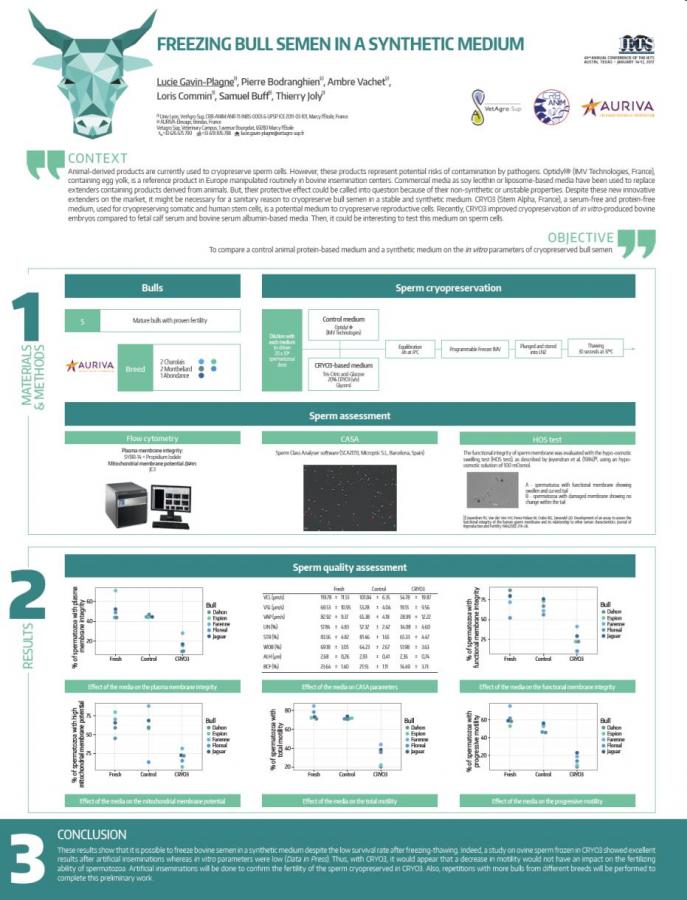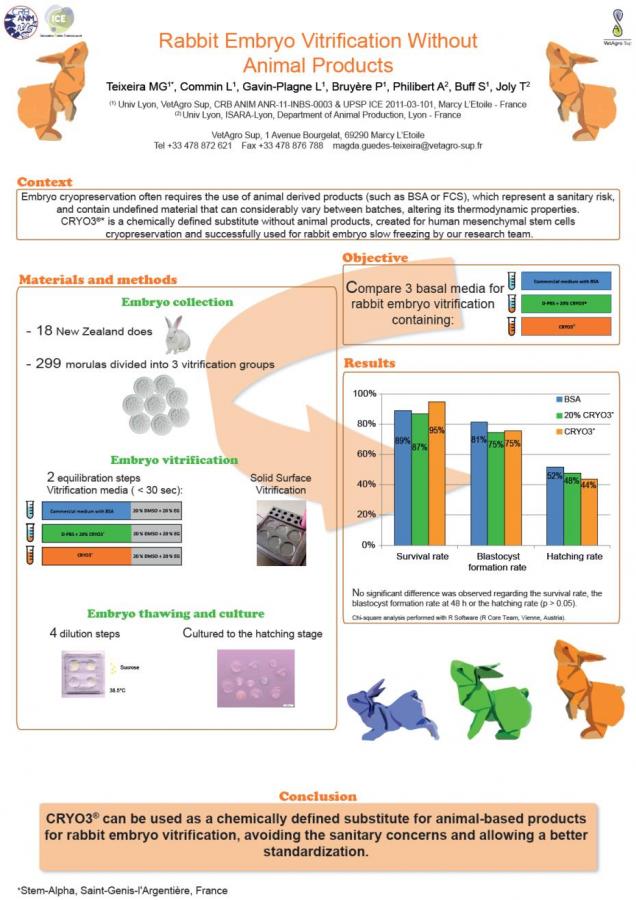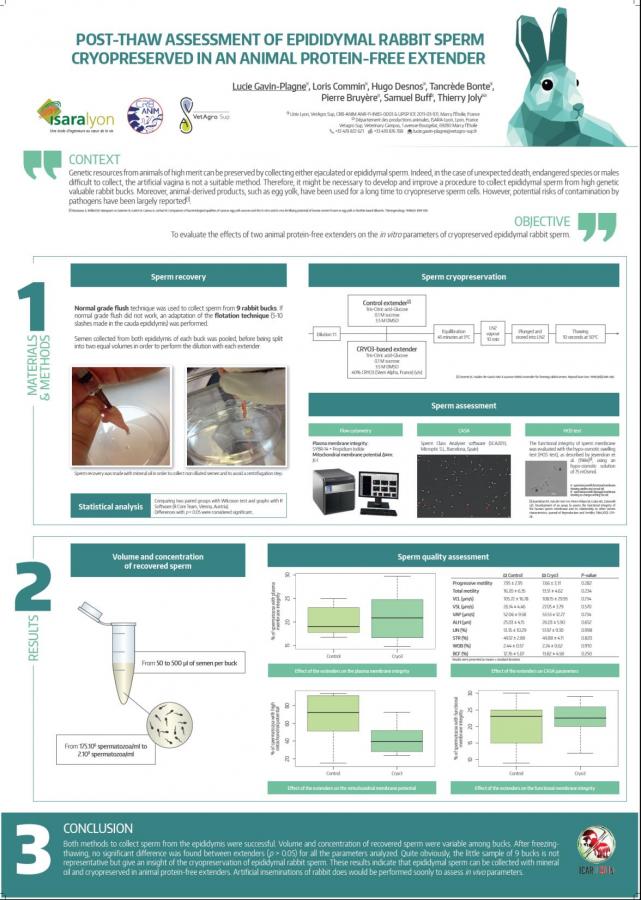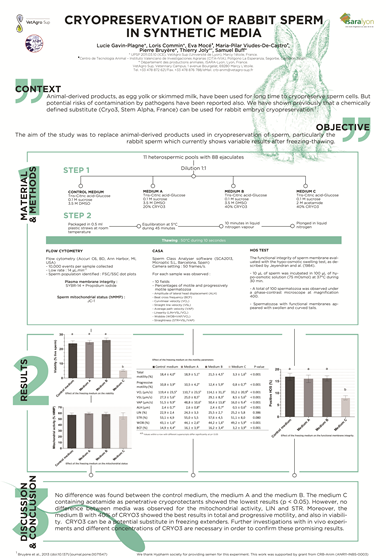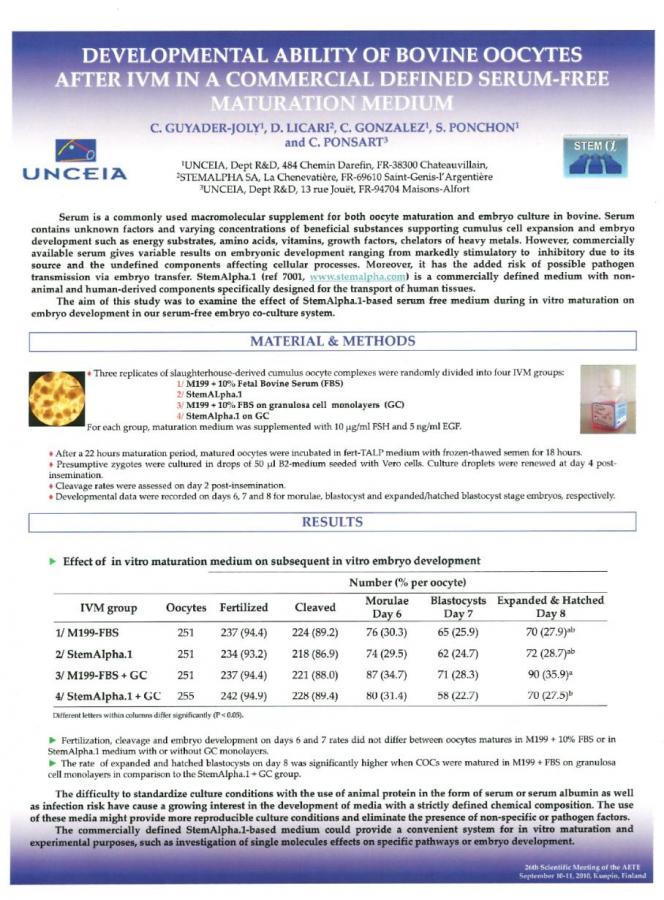STEM ALPHA cryo3 : Publications & POSTERS

Review : Methodological approaches in vitrification: Enhancing viability of bovine oocytes and in vitro-produced embryos. Teresa Mogas et al. Reprod Dom Anim. 2024;59(Suppl. 3):e14623.
PERSPECTIVE : TARGETED DEVELOPMENT AND OPTIMIZATION OF SMALL MOLECULE ICE RECRYSTALLIZATION INHIBITORS (IRIs) FOR THE CRYOPRESERVATION OF BIOLOGICAL SYSTEMS Leah E. McMunn et al. CryoLetters 45(2), 69 – 87 (2024)
15e Symposium du RQR • 15th RQR Symposium Session d’affiches I / Poster session I 07/11/2022 Réseau Québequois en Reproduction, Plaza Centre-Ville Montréal
18 – Benefit effects of Cryo-3 containing medium on bovine embryos cryopreservation Armelle Tchoumi Neree, Yoana Murcia, Jonathan Lehouiller, Raynald Dupras, Younès Chorfi Faculty of Veterinary Medecine, Université de Montréal, St-Hyacinthe, Qc, Canada, Medivet Inc, Notre Dame-du-bon-Conseil, Qc, Canada, 3DMV GenetiQ Inc, St-Germain de Grantham, Qc, Canada
In vitro fertilization (IVF) is an artificial reproduction technique used to produce embryos and combined with cryopreservation technologies enables the improvement of genetic selection. Usually, the supplements used in embryo cryopreservation media are from animal sources ( bovine serum albumin-BSA) and might inhibit blastocyst development. This study proposes to substitute BSA supplementation with Steam Alpha CRYO3 20% in the ethylene glycol (EG)- cryopreservation medium. The CRYO3 is a media without animal sources and contains carbohydrates, amino acids, vitamins and HEPES. The objective was to compare the effects of CRYO3 supplementation with those of BSA 0.4%, on the viability and quality of embryos after thawing. Bovine ovaries were maintained at 35oC in PBS containing amikacin sulphate 250 mg, and heparin 100UI/mL for 1h. In vitro, oocytes were maturated for 24h, fertilized for 18-22h with sperm 2x106Cells/mL and then, cultured for 7 Days. A total of 290 Embryos, divided into 176 and 114 Embryos for CRYO3 and control, respectively, were frozen according to IETS guidelines. Thawed embryos were cultured for 24h. Embryo stage and quality were evaluated according to IETS. The number of thawed embryos that have differentiated to the blastocyst stage after 24h of culture, was 90±7 and 161±11 for control and CRYO3, respectively. For quality 1, embryos were 55 and 75% (p=0.001) in control and Cryo3, respectively. Statistic analysis was done with ANOVA one-way. These results show that CRYO3 plays a relevant role in embryos viability during cryopreservation and might be auseful media for cryopreservation of in vitro bovine embryos.
Biomarker metabolite mating of viable frozen-thawed IVP bovine embryos with pregnancy-competent recipients leads to improved birth rates Gimeno et al. 2023 Journal of Dairy Science Vol. TBC No. TBC, TBC / J. Dairy Sci. TBC https://doi.org/10.3168/jds.2022-23082 (Article in press)
Cryopreservation of germinal stem cells in rainbow trout: a strategy to entirely restore a genotype of interest. Anne-Sophie GOUPIL et al. Conservation NOV’AE Numéro Spécial #02 RARe 2022 54-64
https://www6.inrae.fr/novae/content/download/5539/56184/version/1/file/07_Labbe_NOVAE2022.pdf
Gómez E, Murillo A, Carrocera S, Pérez-Jánez JJ, Benedito JL, Martín-González D and Gimeno I (2022) Fitness of calves born from in vitro produced fresh and cryopreserved embryos. Front. Vet. Sci. 9:1006995. doi:10.3389/fvets.2022.1006995
RABBIT PLURIPOTENT STEM CELLS: A PROMISING AND USEFUL
BIOTEHNOLOGY TOOL Afanassieff M. et al. World Rabbit Science Association
12th World Rabbit Congress – November 3-5 2021 – Nantes, France, Communication BP-02, 4 pp. HAL Id: hal-03719986 https://hal-vetagro-sup.archives-ouvertes.fr/hal-03719986 Submitted on 11 Jul 2022
The Metabolic Signature of In Vitro Produced Bovine Embryos Helps Predict Pregnancy and Birth after Embryo Transfer Isabel Gimeno et al. Metabolites 2021, 11, 484. https://doi.org/10.3390/metabo11080484
Insights into Species Preservation: Cryobanking of Rabbit Somatic and Pluripotent Stem Cells
L Gavin-Plagne, F Perold, P Osteil, S Voisin… – International journal of …, 2020 – mdpi.com
32 Bovine embryo cryopreservation in a chemically defined medium A Østergaard, L Gavin-Plagne… – Reproduction …, 2020 – CSIRO Publishing
Laparoscopic insemination method in sheep allows the use of an animal protein-free and inexpensive freezing medium L Gavin-Plagne, L Boyer, A Baudot… – Annual Conference of …, 2020 – researchgate.net
AQUAEXCEL2020 Deliverable D7.3 Validation of the procedures for germ stem cell isolation, cryopreservation and transplantation in normal trout and carp lines. Integration of the procedures in WP3 standards Ref. Ares(2020)1784045 – 26/03/2020
Comparison Between an Animal-Derived Product Medium and a Chemically Defined Medium for Ram Sperm Cryopreservation L Gavin-Plagne, L Commin, P Bruyere… – Biopreservation and …, 2019 – liebertpub.com
AQUAEXCEL2020 D3.3: Booklet of cryopreservation procedures for the cryobanked species Catherine Labbé, INRA Ref. Ares(2018)4996669 – 28/09/2018

Cellules souches somatiques
Production of Human dental pulp cells
Production of Human dental pulp cells with a medicinal manufacturing approach, 2015. Ducret et al. Basic Research Biology.
Osteoblastic differenciation
Osteoblastic Differentiation of Wharton Jelly Biopsy Specimens and Their Mesenchymal Stromal Cells after Serum-Free Culture, 2014. Andreas A. Mueller et al. Plast. Reconstr. Surg. 134: 59e, 2014.
Mesenchymal Stem Cells
Encapsulation of Mesenchymal Stem Cells by Bioscaffolds Protects Cell Survival and Attenuates Neuroinflammatory Reaction in Injured Brain Tissue After Transplantation, 2013. Anna Sarnowska et al.
Cell Transplantation, Vol. 22, Supplement 1, pp. S67–S82, 2013
Neurogenis properties
Neurogenic Properties and a Clinical Relevance of Multipotent Stem Cells Derived from Cord Blood Samples Stored in the Biobanks, 2012. Marcin Jurga et al. STEM CELLS AND DEVELOPMENT Volume 21, Number 6, 2012.
Communications
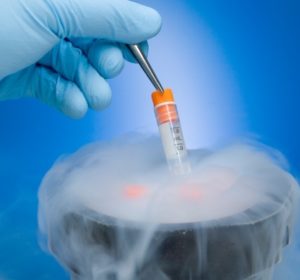

De la recherche...
STEM ALPHA.Cryo3 #5617
Sarah Janati Idrissi. Cryoconservation d’embryons bovins produits in vitro et biopsiés. Biologie de la
reproduction. Université de Lyon, 2022. Français. NNT : 2022LYSE1020. tel-03945737 https://theses.hal.science/tel-03945737
A Chemically Defined Medium for Rabbit Embryo Cryopreservation
Pierre Bruyère, Anne Baudot, Thierry Joly, Loris Commin, Elodie Pillet, Pierre Guérin, Gérard Louis, Anne Josson-Schramme, Samuel Buff ; PLoS ONE 2013 August 2013 | Volume 8 | Issue 8 | e71547
Improved cryopreservation of in vitro-produced bovine embryos using a chemically defined freezing medium Pierre Bruyère 2012 Elsevier Inc.

Usage Vétérinaire
Rapid cooling of rabbit embryos 2018
Magda Teixeira1,*, Loris Commin1, Lucie Gavin-Plagne1, Pierre Bruyère1, Samuel Buff15 , Thierry
Joly1,2
Abstract
Embryo cryopreservation media usually contain animal-derived products, such as bovine serum albumin (BSA). These products present two major disadvantages: an undefined variable composition and a risk of pathogen transmission. We aimed to evaluate the effect of replacing BSA in rabbit embryo rapid cooling “freezing” and warming media with a chemically defined medium with no animal-derived products: STEM ALPHA.Cryo3 (“Cryo3”). A total of 1540 rabbit morulae were divided into three cryopreservation groups (group 1: BSA, group 2: 20% Cryo3 and group 3: 100% Cryo3) and a fresh controls group. After rapid cooling, embryos were cultured (in vitro approach), or transferred into synchronized does (in vivo approach). In the in vitro approach, post-warm survival rates obtained with 100% Cryo3 (94.9 %) were superior to BSA (90.8%) and 20% Cryo3 (85.6 %). The blastocyst formation rate was similar between BSA, 20% Cryo3 and 100% Cryo3 groups (85.1, 77.9 and 83.3 %, respectively), as was the expansion / hatching rate (63.1, 63.4 and 58.0%, respectively) and embryo mitochondrial activity. In the in vivo approach, pregnancy (80.0, 68.0 and 95.2 %, respectively), implantation (40.5, 45.9 and 44.8%, respectively), and live-foetus rates (35.6, 35.5 and 38.1 %, respectively) were similar between the three groups. To conclude, Cryo3 can replace BSA in rabbit embryo rapid cooling “freezing” and warming media.
Ram Sperm Cryopreservation 2018
Comparison Between an Animal-Derived Product Medium and a Chemically Defined Medium for Ram Sperm Cryopreservation
Lucie Gavin-Plagne,1,* Loris Commin,1,* Pierre Bruye` re,1 Samuel Buff,1 and Thierry Joly2
Animal-derived products are widely used in sperm cryopreservation for their cryoprotective properties. These components, however, tend to be replaced because of sanitary risks. STEMALPHA.CRYO3 (Ref. 5617; Stem Alpha, Saint-Genis-l’Argentiere, France), called ‘‘CRYO3,’’ is a chemically defined preservation medium
currently used for freezing human tissue and adult stem cells. The aim of this study was to evaluate the effect of a CRYO3-based medium on ram sperm freezing regarding in vitro parameters and in vivo fertility. Semen from nine Charolais rams was collected using an artificial vagina, then split and frozen using two media: a CRYO3- based medium or a control medium containing egg yolk (10%) and milk (45%). Sperm membrane integrity (propidium iodide [PI]/SYBR-14 and calcein AM/ethidium homodimer-1), acrosome integrity (FITC-PNA/PI), and mitochondrial membrane potential ( JC-1) were assessed using flow cytometry, while functional membrane integrity was assessed using a hypo-osmotic swelling test and motility parameters, evaluated by computerassisted sperm analysis. Pregnancy rates, prolificacy, and the average daily weight gain (DWG) of lambs were evaluated after performing 195 laparoscopic inseminations. The control medium showed significantly higher results than CRYO-based medium for all in vitro parameters, except for linearity and straightness (motions parameters). Conversely, field trials showed no significant difference between the control medium and the CRYO3-based medium for pregnancy rates (72.2% and 67.9%, respectively), prolificacy (1.8 and 1.6, respectively), and the DWG (0.34 and 0.35 kg/d, respectively). This preliminary study showed that CRYO3 cannot replace egg yolk and milk in freezing extenders for commercial purposes. However, as laparoscopic inseminations allowed a 67% pregnancy rate, CRYO3-based medium remains an option for international transport or long-term storage of genetic diversity.
STEM ALPHA.Cryo3, 2015
Caractérisation du sperme de lapin congelé en milieux synthétiques

...vers un usage thérapeutique.
STEM ALPHA.Cryo3 #5617
Cancer cells transfer invasive properties through collagen-tracks
Frederic Saltel et al. 2023 July 24th, 2023 DOI: https://doi.org/10.21203/rs.3.rs-3143192/v1
Abstract
Invasion and migration through the extracellular matrix are prerequisites for metastasis, the leading cause of cancer-related deaths. During tumor development, the extracellular matrix is remodeled, including by overexpressing type I collagen that facilitate cancer dissemination. Most studies have focused on events at the leading edge as cells invade. We describe a new event at the trailing edge, as cells detach from the matrix. We show that small vesicles containing the collagen receptor DDR1 are left behind on collagen fibrils in the migration path. We named these structures attached to the collagen fibers « collagentracks ». The vesicles are similar in size to exosomes but lack the exosome markers, and they also are different to migrasomes. We show that collagen-track formation is stimulated by DDR1 and by factors that promote adhesion, including collagen cross-linking. We report the protein, mRNA and miRNA content of collagen-tracks. They contain adhesion proteins, suggesting that they form when membrane fragments containing adhesions are torn from the cell as it migrates along collagen fibrils. We show that collagen-tracks are deposited by breast cancer cells in 3D matrices in vitro and in vivo. Collagen-tracks are stable and can be taken up by surrounding cells, promoting epithelial to mesenchymal transition, matrix degradation and invasion, finally leading to increased lung metastasis of breast cancer cells. In summary, we have identified and characterized a new vesicle entity directly attached to collagen fibrils that plays a role in cell-cell communication and can transfer invasive properties to surrounding cells. We conclude that cancer-related collagen-tracks are a new player acting locally to drive tumor invasion and metastasis
***
Neurogenic Properties and a Clinical Relevance of Multipotent Stem Cells Derived from Cord Blood Samples Stored in the Biobanks Marcin Jurga, Nico Forraz, Christina Basford, Gianluigi Atzeni, Andrew J. Trevelyan, Saba Habibollah, Hamad Ali, Simon A. Zwolinski, and Colin P. McGuckin. Stem Cells and Development. April 10, 2012, 21(6): 923-936. doi:10.1089/scd.2011.0224.


